A Mini-Mauser - The Remarkable Gunsmiths Fire Up Another Project
August 1, 2017
It was a fun road trip. Prescott is a beautiful city, and the drive up always seems to be a pleasant outing; besides, the destination is not only the city.
For those of you who haunt gun shops, looking for deals, military surplus, bulk ammo etc., if you have not been to J&G Sales, let's just say that you are missing out. Through the years, I have obtained some very sweet deals on some great guns. Besides, the trip allowed us the opportunity to have a Ruben Sandwich at the Dinner Bell, a place I found on a previous trip with my son-in-law, Tim.
Mini-Mauser Is Eye Catcher
One of the firearms that had caught my interest was a Mini-Mauser. This was made by a company called Zastava Arms in Serbia. Sold as the model 85, it was also marketed by Remington as the Model 799. Zastava has been around, and making guns since 1853. Located in Kragujevac (easy for you to say, and spelled just like it sounds...) (note: I walk a thin line here as my wife is of Serbian descent), they have been making Mauser-designed products since 1880 for noted firms and countries to include FN in Belgium.
Two Calibers To Consider
There were a couple of example rifles up on the display wall, but one of the nice things about J&G is they will allow you to see several if they have them, so you can select your rifle. There were two calibers available, both of military origins.
The first was 5.56 x 45 mm, our standard military rifle cartridge. This is the military designation of the commercial .223 Remington, with a couple of small differences adopted during development. The military specification calls for a longer throat area in the chamber, and allows for a slightly higher chamber pressure.
It was nice that the Zastava had the military spec. chamber to allow a greater selection of ammo. It can, however, have an effect on accuracy. There are actually three very similar chambers out there - the previously described 5.56 x 45, the .223 Remington, and the .223 Wylde (a hybrid chamber, which permits the use of cartridges of either specification).
The second caliber available was the Russian standard 7.62 x 39 mm of AK 47 fame. This weapon, along with its predecessor the SKS, do not have reputations for stellar accuracy, and yet custom rifles have been built with rounds based on this case, with some very impressive results.
Decision: One Of Each!
The price was right, so as Pat and I looked over several examples, the question was which caliber to choose. And then it hit me: "Mini" means small, so if they are small, I will just get two. One of each! The wood stocks selected had nice figure, with one light and the other dark, to make it easy to tell them apart.
I freely admit to being a bit different, in that neither rifle was fired as it came. Instead, they were both disassembled, glass bedded and the barrels floated, as well as the triggers tuned. Rings and mounts were obtained, and the rifles scoped. I envisioned the 5.56 x 45mm as an excellent rifle to promote the grandkids from .22 s with, not to mention a fun, plinker.
Just The Ticket
The 7.62 x 39 brought other thoughts to mind. My home in Florence is located in Javelina Central. We are totally surrounded by areas that are prime Javalina habitat, and a very liberal availability of tags from the Arizona Game and Fish Department. An accurate bolt action rifle in this caliber would be just the ticket, and with a starting weight of just over 7 pounds, a lighter weight would be an added bonus.
The 5.56 x 45 rifle met and exceeded every accuracy expectation. It seemed to shoot anything well, from military surplus NATO specification ball, to the hand loads I had worked up for my old Remington 700 Varmint Special.
A Different Story Altogether
The 7.62 x 39 was a different story altogether. The steel-cased, poly coated ammo was difficult to extract, and after trying numerous reloads and types of factory ammo, to say that I was disappointed would be a gross understatement. The only load that shot well was the Winchester white box stuff. I tried getting as close to the same velocity as I could, identical bullet weights loaded in their cases. I even pulled the Winchester bullets and tried substituting a hunting bullet of the same weight, but nothing worked.
Then Pat decided to measure the barrel. Some 7.62 x 39 barrels were made with a .308 bore, but most were bored .310. The bad news was that this barrel had squeaked past quality control at a loose .311 bore diameter. No wonder there was an accuracy problem.
What To Do?
The question was now what to do. I have no doubt that a call to Zastava would have resulted in their correcting the problem, and yet there were other more interesting possibilities. Having a rifle that is different than someone else's is a large part of the gunsmithing that we do. Looking at the barrels in stock resulted in locating a 24 inch light contour fluted stainless steel .308 diameter blank.
Having the longer barrel would allow the opportunity to play with some non-typical powders, and the Lee Precision reloading dies come with neck expanders in both .308 and .310 diameters. Also, the bullet selection for .308 diameter is phenomenal. A quick check showed that a chamber reamer with a .308 diameter pilot was available. So we were all set - wait, not so fast!
Disassembly was straight forward until it revealed the receiver threads. They were metric 26 x 1.5 LH, and were not available on the lathe. I was very concerned, but Pat had a solution that involved cutting the threads to 18 t.p.i., and then hand lapping them to fit the receiver.
Significant Work Involved
While this is simple in theory, the work involved was significant. We took turns, and Pat made it look easy. It wasn't, and it took a full week for my wrists to stop hurting. The result was a super fit, and the remainder of the barreling operation went without incident. Finished barrel length is now 23 inches with a recessed 11 degree target crown, and a matte stainless finish.
The rifle is just slightly muzzle heavy, and balances right behind the front receiver screw. Handling is excellent, and accuracy is now where it should be, with most loads under one inch. An interesting load that I am still developing uses a Barnes 110 grain TAC-TX FB designed for the .300 AAC Blackout cartridge. Using shortened Fiocchi cases to get back to the correct overall length, this load is showing exceptional potential. I am really looking forward to development of some heavier bullet loads (150- 168 grain range). Good luck, and safe shooting.


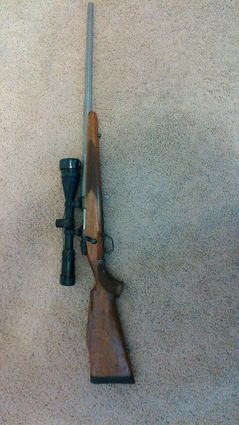
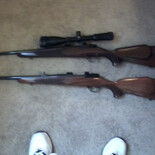
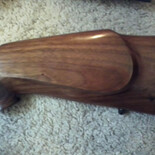
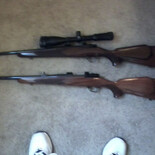
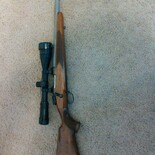










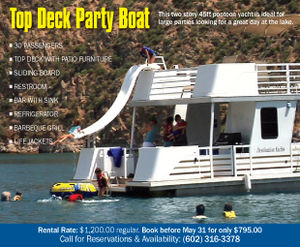


Reader Comments(1)
TonyK writes:
Any idea what kind of pressures the M85 with the 7.62x39 boltface will handle? I'm waiting on a Left Handed 6.5 Grendel rebarrel from E.R. Shaw, and not looking to duplicate AR loads with a bolt gun. M1943 Ball pressures run on the low side, I think.
08/14/2020, 8:55 am